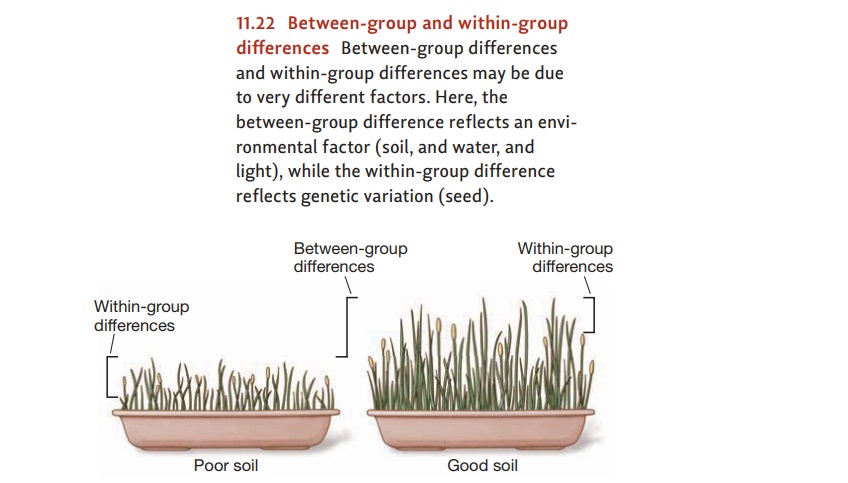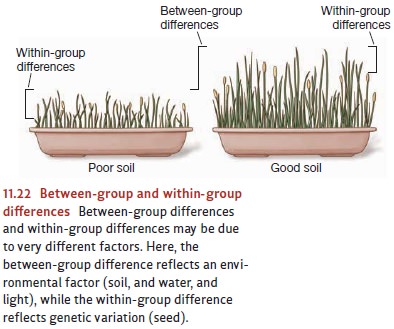Chapter: Psychology: Intelligence
Group Differences in IQ: Between - Group and Within – Group Differences

BETWEEN - GROUP AND WITHIN – GROUP DIFFERENCES
The
differences in intellectual performance between men and women, and also between
whites and blacks, are relatively small. But the debate over these differences
has been large and heated, and often framed in terms of heritability. To what
extent is it helpful to think about these differences in terms of genetics? To
what extent should we focus on the cultural surround, including differences in
education or opportunity?
Before
addressing these issues, we need to deal with a methodological point. We’ve
discussed considerable evidence that genetic patterns matter a lot for
intelligence; indeed, heritability estimates are as high as .80 for some
groups. But we’ve also emphasized that these estimates apply only to a particular
group: How much variation is there within
thatgroup? How much of that group’s variation
can be understood in genetic terms? As we firstdiscussed, and as we’ve
reiterated here, the estimates—by definition—come from a group’s data and
cannot be applied to other groups. By the same logic, these same estimates
certainly can’t be used in comparing one group to another.
To
make this point concrete, many scholars rely on a straightforward example:
Imagine you’ve just bought a bag of grass seed at the garden store. The bag is
likely to contain just one variety of seed—perennial rye grass, for example—but
even so, it’s unlikely that the seeds are all clones of each other, and so
there will be some genetic variation from one seed to the next. Let’s now
imagine that you plant a handful of this seed in barren soil and give the
plants poor-quality care. You don’t water them enough, and they have minimal
exposure to sunlight. In this setting the plants are likely to grow poorly, but
some will do better than others—will be a bit healthier perhaps, or grow a bit
taller. These differences from one plant to the next can’t be attributed to
environmental factors because, in this scenario, all of the seeds are in
exactly the same environment: They all get the same low levels of nutrition;
they all get the same bad care. If, therefore, some plants do better than
others, their success must be attributed to genetic factors—some seeds are
biologically better prepared for these poor conditions.
Now
imagine another handful of seeds drawn from the same bag. These seeds are
planted in rich soil and given excellent care. These plants will grow well—but
again, some will grow taller than others. As before, these variations from one
plant to the next can’t be explained in terms of environmental factors, because
all of these seeds are growing in exactly the same environment. Hence, we can’t
say that some plants grew taller because they got more water, or more light,
because all plants got the same amount of water and light. Instead, the
observed variation must be attributed entirely to genetic sources—some seeds
are better prepared to flourish in this rich environment.
Notice
where all of this leaves us. In the first environment, the within-group
differences (comparisons among the various seeds growing in barren soil) are
all produced by genetics. The same is true in the second environment; here,
too, the within-group differences are produced by genetics. Thus, if we were to
calculate the heritability of plant height (or any other measure of the plants’
status) for either group, we get a value of 1.0—all of the variation within each group is due to genetic factors.
What
about the comparison between the two groups? This difference is obviously
attributable to the differences between their respective environments, in which
one group gets high-quality care and the other does not (after Lewontin, 1976;
Figure 11.22). Therefore it’s the environment, and not genetics, that accounts
for the between-group comparison—and so the heritability for this comparison is
zero.
In
this case, then, the between-group difference comes from a very different
source than do the within-group differences. And that’s the point: Even if we
know a lot about within-group variation (specifi-cally, if we know that this
variation depends on the genes), we can draw no conclusions about what produces
between-group variation. Sometimes between-group variations come from the same
source as within-group variations, but sometimes they don’t. Knowing a lot
about one type of variation tells us nothing about the other.

Related Topics